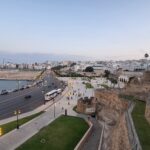If you never heard of Morocco’s blue city, you are in for a cool walk through Chefchaouen, Morocco. Every wall, every doorway, every staircase seemed dipped in shades of blue—cerulean, indigo, turquoise, and sky. It felt less like walking into a town and more like stepping into a dream.
Chefchaouen is often called the Blue Pearl and it’s within the Rif Mountains of northern Morocco. On a day trip here, you don’t just see the city—you feel it. The rhythm of footsteps on cobblestones, the scent of spices drifting from market stalls, and the laughter of children echoing through narrow alleyways all combine into an unforgettable experience.
- Morning Arrival: First Glimpse of the Blue City
- Wandering the Medina: A Walking Tour of Chefchaouen
- Midday Pause: Tastes of Morocco
- Afternoon Adventure: Ras El Maa
- Last Stop: The Kasbah
- Practical Tips for a Chefchaouen Day Trip
Why Is Chefchaouen Painted Blue?

The Chefchaouen medina is a maze of narrow streets painted in every shade of blue imaginable. Legend says the color was introduced by Jewish refugees fleeing the Spanish Inquisition in the 16th century. Blue represents the sky and heaven in Jewish tradition—a reminder of spiritual connection. Some locals believe blue repels mosquitoes (though not scientifically proven).
Over time, residents painting blue and white became widespread in the 1930s as the city embraced its blue identity. And, according to my tour guide, it was not until the early 2000’s when most of the residents decided to paint it blue and white to drive more tourism into the city. Today, it gives the city its surreal, calming atmosphere. It’s a visual signature that draws photographers and travelers from around the world, and it sure drew me as well. 🙂
Morning Arrival: First Glimpse of the Blue City

I arrived from Tangier after a two-hour drive through winding mountain roads. The journey itself was a prelude to the magic—rolling hills, olive groves, and glimpses of shepherds guiding their flocks. But nothing compared to the moment I entered the medina.



At the medina, you can immerse yourself in the atmosphere. Walking through the medina feels like a dream, you’ll want to stop and take a million photos, and the locals have set up spaces for you to do just that. You will also find a cat in every corner.
Wandering the Medina: A Walking Tour of Chefchaouen
Walking through Chefchaouen is best done slowly. Every corner reveals a new photo-worthy scene:



Along the way you will encounter local vendors selling handwoven blankets, leather goods, and silver jewelry. The Kasbah, is a 15th-century fortress with gardens and a small ethnographic museum worthy of the entrance fee and spending time here to learn more about the history. And for the views and photo ops.
I stopped often, not just to take photos, but to breathe it all in. The pace of life here is unhurried, and that’s the beauty of it.
Midday Pause: Tastes of Morocco
By noon, the sun lit up the blue walls in dazzling brightness. I ducked into a rooftop café overlooking the medina and La Kasbah. Food in Chefchaouen is rich in flavor. If you visit, don’t miss trying freshly baked Moroccan bread from a street vendor.
From the rooftop I watched the city move below me as I waited for my food—shopkeepers arranging displays, travelers wandering with wide eyes, locals chatting in doorways. I ordered a delicious quinoa salad with smoked salmon, and it came with a pleasant surprise of avocado slices. Then I tried the Pastila as my main entree. And of course, Moroccan mint tea. Moroccan food is absolutely delicious!



Afternoon Adventure: Ras El Maa
In the afternoon, I followed the sound of rushing water to Ras El Maa, a small waterfall on the edge of town where locals gather to wash clothes and cool off.

From there, I hiked up to the Spanish Mosque, perched on a hill overlooking the city. The climb took about 20 minutes, and the reward was breathtaking: a panoramic view of Chefchaouen’s blue medina against the backdrop of the Rif Mountains.

Last Stop: The Kasbah
La Kasbah is not just a historical monument—it’s the soul of Chefchaouen and also a museum. Whether you’re drawn by its architecture, its stories, or its peaceful gardens, this fortress invites you to slow down and connect with Morocco’s rich heritage. The views from the Kasbah are stunning, worth the entrance fee. My tour did not have this included, but on my free time, I could not miss the opportunity to explore it.



Practical Tips for a Chefchaouen Day Trip
- Best Starting Point: Tangier or Tetouan (1.5–2 hours away). Fez is possible but longer (4 hours).
- What to Wear: Comfortable walking shoes—Chefchaouen’s streets are steep and uneven.
- Best Time to Visit: Spring and fall for mild weather. Summer can be hot, but mornings and evenings are pleasant.
- Photography Tip: Visit early in the morning for quieter streets and softer light.
A day trip to Chefchaouen is more than sightseeing—it’s an immersion into color, culture, and calm. Walking through its blue-painted streets feels like wandering through a living work of art. Whether you’re exploring the medina, sipping mint tea on a rooftop, or learning about its history from the Kasbah, Chefchaouen is that dream-like place that makes you smile every time you remember it.
For me, it wasn’t just a day trip. It was a reminder of why we travel: to find beauty in unexpected places.



